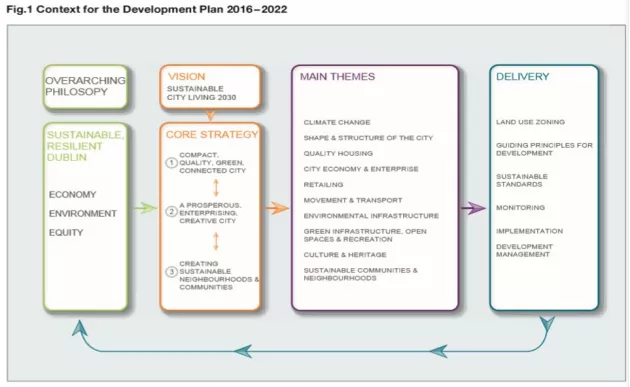1.2 A New Approach (Context for the Development Plan 2016 – 2022)
1.2 A New Approach (Context for the Development Plan 2016 – 2022)
The Development Plan sets out a new approach to meet the needs and aspirations of citizens of Dublin and the country, not only for the 6-year life of the plan, but for the long term. This approach is based on the principles of sustainability and resilience on the social, economic and environmental fronts.
This approach imbues the Development Plan throughout, cascading from the vision, core strategy, policies, objectives and standards through to implementation. The implementation of the measures in the City Development Plan will be pursued by active land management, whereby the City Council, through its departments and in collaboration with other agencies, will pro-actively work to achieve the aims of the core strategy.
The vacant land levy is a key means of implementing the active land management approach, and the development plan in relevant chapters provides for the implementation of the vacant land levy as set out in the Urban Regeneration and Housing Act 2015 (see also Sections 6.5.4 and 15.1).
The new approach for this city development plan is based on the approach set out in the 2011 – 2017 plan, but which was largely untested due to the recession. It has also been adjusted to take on the increasing concern at national and global level about climate change, carbon emissions and the depletion of the earth’s resources. It is also notable from the consultation process to date that there is a desire to ensure that Dublin becomes a quality, green, and accessible city with a thriving economy.
It is from these processes that the overarching approach for this development plan and beyond has emerged and which are described briefly as follows:
A sustainable, resilient Dublin Dublin must make the transition to a lowcarbon sustainable city. The evidence and costly implications of not doing so are indisputable and the benefits of a more sustainable city are numerous. Dublin has made some good progress, but the scale of the challenge is such that there is a need for a coherent and strategic response. Addressing climate change is crucial, and Chapter 3 of the plan is dedicated to this issue.
There are compelling reasons for making Dublin a sustainable and resilient city. A shift in behavioural patterns, renewable energy sources and sustainable infrastructure is critical for the city to make its contribution to emissions reductions and to increase the resilience of the city’s economy. There is also a strong economic case for climate change mitigation. The Stern Review (2006), for instance, states that the cost of inaction is far greater than the cost of early action. Dublin must make the transition to a low-carbon and ultimately a post-carbon economy to become a competitive, resilient, socially inclusive and sustainable city.
The alternative is to continue along an unsustainable path of low-density development with extensive urban sprawl, unsustainable travel patterns, high levels of fossil fuel consumption and a reliance on imported energy sources. This unsustainable path will undoubtedly result in costly penalties for late or non-compliance on climate change commitments, irreparable damage to the city’s image and branding as a clean, green, knowledge economy and will impede the ability of the city to become a centre of innovation and creativity.
It will also increase the likelihood of strategic risks in terms of the city’s vulnerability to uncertainties in global energy supplies and the impacts of extreme weather events due to climate change. This alternative is simply not a viable option for Dublin. Achieving a more sustainable and resilient city the application of the following principles at all levels, from plan making to urban projects and development management, will help to deliver a better quality of life for all. The principles constitute inter-related and essential elements of a sustainable approach to future development of the city:
a) Economic – Developing Dublin as the national gateway at the heart of the Dublin region and the engine of the Irish economy, with a network of thriving spatial and sectoral clusters, as a focus for employment and creativity.
b) Social/Residential – Developing Dublin as a compact city with a network of sustainable neighbourhoods which have a range of facilities and a choice of tenure and house types, promoting social inclusion and integration of all ethnic communities.
c) Cultural/Built Heritage – Making provision for cultural facilities throughout the city and increasing awareness of our cultural heritage and promoting safe and active streets through the design of buildings and the public realm.
d) Urban Form – Creating a connected and legible city based on active streets and quality public spaces with a distinctive sense of place. Place making is particularly important in the strategic development and regeneration areas (SDRAs).
e) Movement – Helping to build an integrated transport network and encouraging the provision of greater choice of public transport active travel.
These components of the over-arching philosophy for the new development plan have informed the vision and the core strategy for the city, both of which are elaborated upon in the next chapter.
